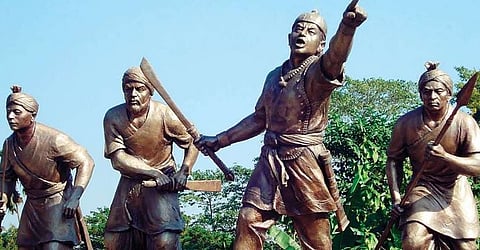
- Home
- Live Blog
- Breaking News
- Top Headlines
- Cities
- NE News
- Sentinel Media
- Sports
- Education
- Jobs

Most ethnic groups and tribal communities across the North-eastern region are currently undergoing a phase where they are struggling to protect their respective identities. Over 200 years ago, majority of the communities across the region had practiced various indigenous faiths, which mostly revolved around worship of Nature. Trees, rocks, rivers, thunder, rain, earth, animals — Nature was worshipped in various forms, each depicting or denoting a particular aspect or power of Nature. With the expansion of Hinduism in the remote past, as also when groups of people from mainland India started arriving in the region, it led to expansion of various Hindu sects, particularly to the Brahmaputra Valley. The Ahoms, for instance, had brought with them their own deities when they had arrived in Assam in the third decade of the thirteenth century.
But then, while they ruled over the larger portion of present-day Assam, hardly did they try to enforce their original faith upon the subjects. Instead, the Ahoms, who had first adopted and enriched the local Assamese language, later also adopted Hinduism, in the process getting Brahmin priests from Bengal and central India to run Hindu temples that they established and began patronizing. When Srimanta Sankaradeva propounded his ‘Ek-sarana naam-dharma’, he too did not enforce it on others, but adopted a rather democratic and open strategy which not only attracted Brahminical priests, but also people from other faiths. This way he also reduced the impact of typical Hindu casteism in the broader Assamese society. The Vaishnavite Satra institutions that were established following Sankaradeva’s teachings too adopted an open system, in which there was neither any compulsion on people to join them, nor any exclusion if one did not. Things however drastically began to change with the arrival of the Christian missionaries in the region, beginning with the American Baptist Mission within less than a decade of the annexation of Assam to British India.
The British did invite the evangelists to win over the ‘wild’ tribals with the message of the gospel and it took hardly one hundred years for most tribals of the region, barring those of Tripura and present-day Arunachal Pradesh, to owe allegiance to a new faith. Things have also begun to change rapidly in these two States in the past three or four decades, with a sizeable section of tribal communities abandoning their respective indigenous faiths and adopting a new religion. Different people cite different reasons behind the conversions — ranging from getting out of the clutches of superstitions to freeing oneself from lengthy and expensive rituals. Education and healthcare however are two aspects that have played a major role in communities almost en masse switching over to a new faith, while some have a point in stating that conversions have changed lives of people for good. It is however a matter of debate and examination whether people — individuals as well as communities — have adopted new faiths voluntarily, under certain compulsions, or under some kind of allurement.
Arunachal Pradesh had way back in 1978 enacted the Arunachal Pradesh Freedom of Religion Act, which prohibits forcible conversion. The Act clearly said that “No person shall convert or attempt to convert, either directly or otherwise, any person from indigenous faith by use of force or by inducement or any fraudulent means, nor shall any person abet any such conversion”. Despite that however, the percentage of Christians among the tribal population of Arunachal Pradesh has risen from 13.6 percent in 1991 to 40.9 percent in 2011. Worried over the changing demography in the frontier State that shares over 1,000 km of international boundary with China, the present government in 2017 created an independent department to look after preservation, protection and promotion of the rich indigenous cultural heritage of the State.
As Chief Minister Pema Khandu had put it while announcing creation of the said department, the indigenous communities of the State were fast getting disconnected with their rich culture and languages due to globalization, exposure and external influences. While such issues have occasionally emanated from Majuli, the heart of Vaishnavite art, culture and faith, the movement for preservation of indigenous Khasi faith in Meghalaya from being ‘swamped’ by Western ideas has completed 120 years. While it is a fact that Christian missionaries had contributed immensely towards spread of education in the remote areas of the region where the government was practically invisible for long, it is also a fact that much of the rich cultural practices of the communities — as has been indirectly pointed out by Pema Khandu — are on the verge of being gradually wiped out, if not already so. The debate, however, can go on.